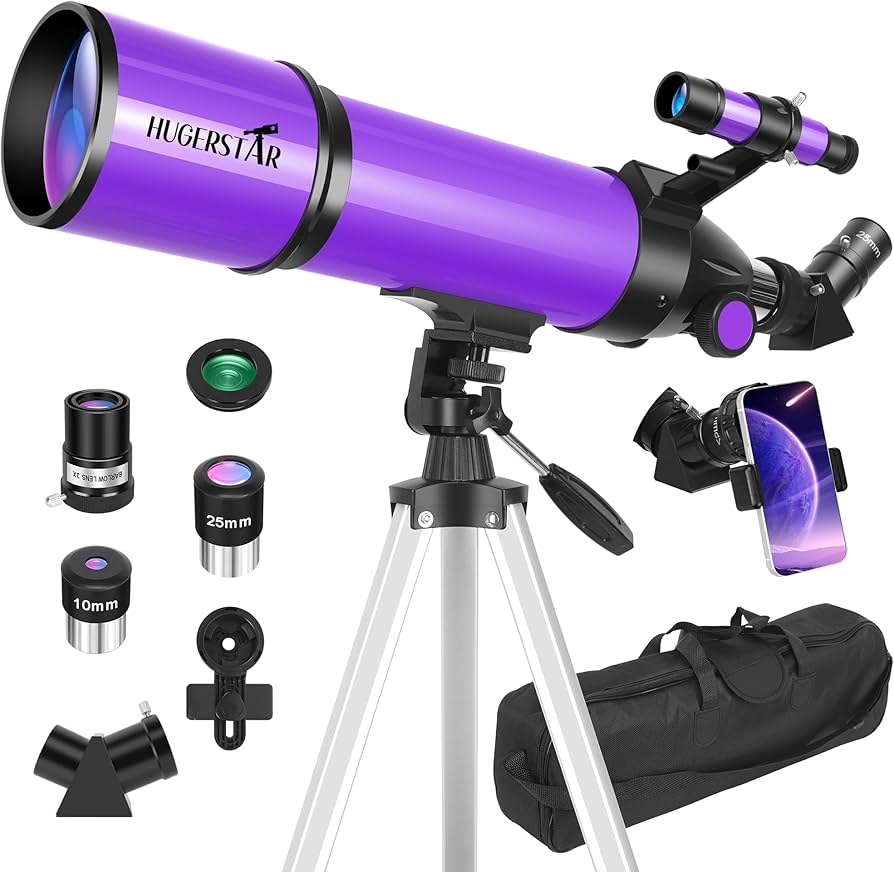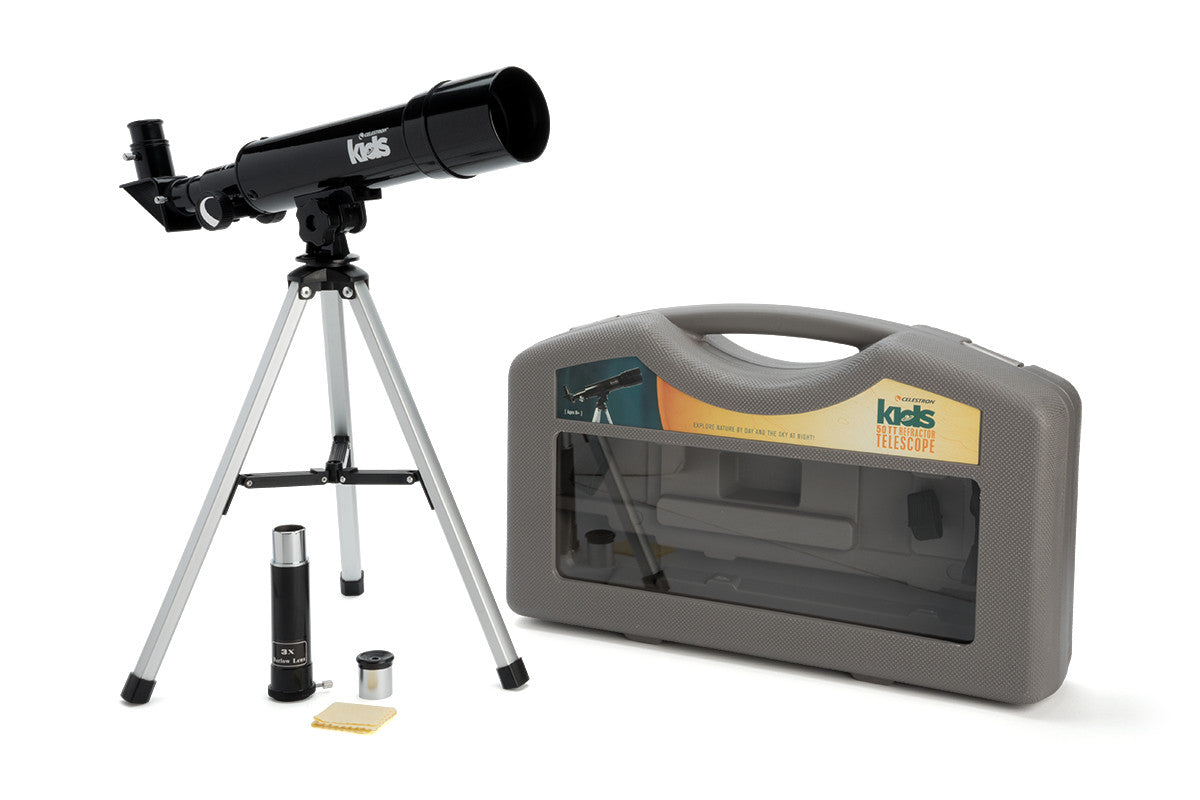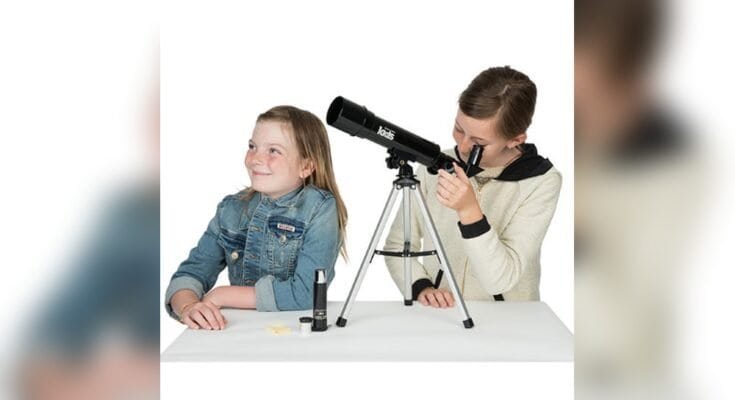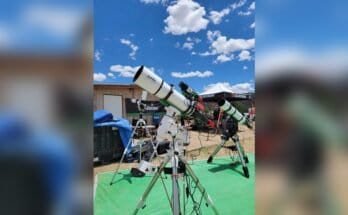Are you looking for a fun and educational way to spark your child’s curiosity about the stars? A refracting telescope for kids could be exactly what you need.
It’s simple to use, safe, and opens up a whole new world of discovery right from your backyard. Imagine your child’s excitement as they see the moon’s craters or distant planets with their own eyes. Keep reading to find out how to choose the perfect telescope that will make learning about space an unforgettable adventure for your family.

How Refracting Telescopes Work
Refracting telescopes use lenses to help us see faraway objects like stars and planets. They bend light to make small things appear bigger and clearer. Understanding how these telescopes work can make stargazing more fun and interesting for kids.
Basic Lens Mechanics
A refracting telescope has two main lenses. The first lens is called the objective lens. It collects light from distant objects. The second lens is the eyepiece. It helps you see the image up close. Lenses bend light to focus it. This bending is called refraction. The objective lens bends light to form a small image inside the telescope.
Light Path In The Telescope
Light enters through the objective lens. This lens bends the light rays so they meet at a point called the focus. The light then travels to the eyepiece lens. The eyepiece lens bends the light again. It makes the image larger and easier to see. The path of light goes straight through the tube of the telescope. This path helps keep the image clear and sharp.
Magnification Explained
Magnification means making objects look bigger. The telescope’s magnification depends on the lenses used. It is the ratio of the objective lens size to the eyepiece lens size. A bigger objective lens gathers more light. A smaller eyepiece lens increases magnification. Kids can change eyepieces to see different levels of zoom. This helps explore the night sky in detail.
Choosing The Right Telescope For Kids
Choosing the right telescope for kids can make their first experience exciting and fun. The right telescope helps children explore the night sky easily. It should fit their age, interest, and skill level. Some telescopes are simple to use, while others are more advanced. Picking the best one means considering size, safety, and cost. These factors ensure kids enjoy stargazing safely and comfortably.
Size And Portability
Small telescopes are easier for kids to carry and handle. A lightweight model lets children move it outside quickly. Large telescopes can be hard to set up and heavy to move. Choose a size that fits your child’s strength and space. Portability helps kids stay excited about using the telescope often.
Durability And Safety Features
Kids need a telescope that lasts through rough use. Look for sturdy materials like plastic or metal. Avoid fragile parts that break easily. Safety features like rounded edges protect little hands. Some models have lens covers to keep glass safe. Durable telescopes give parents peace of mind and kids a fun time.
Budget Considerations
Telescope prices vary widely. Set a budget that suits your family’s needs. Cheaper models can still offer good quality for beginners. Avoid very expensive or complicated telescopes for first-timers. A fair price ensures you get a useful telescope without overspending. Saving money allows upgrading later as skills grow.
Setting Up Your Telescope
Setting up your refracting telescope is an exciting first step to exploring the stars. This guide will help kids put their telescope together quickly and easily. Clear instructions make the process fun and stress-free.
Assembling The Parts
Start by unpacking all the pieces carefully. Lay them out on a clean, flat surface. Find the main tube, tripod, eyepiece, and lens cap. Attach the main tube to the tripod stand. Use screws or clips provided. Make sure the tube is steady and does not wobble.
Aligning The Lenses
Next, check the lenses inside the tube. The objective lens is at the front and collects light. The eyepiece lens is at the back and magnifies the image. Ensure both lenses are clean and free from dust. Align the eyepiece with the main tube. This helps create a clear and sharp view.
Adjusting Focus
Look through the eyepiece at a distant object. Slowly turn the focus knob until the image is sharp. Avoid moving the telescope too fast. Take time to find the clearest picture. Proper focus makes the stars and planets stand out bright and clear.

Fun Activities With Your Telescope
Exploring the night sky with a refracting telescope is exciting for kids. It helps them learn about stars, planets, and other space wonders. Playing with the telescope offers many fun activities that make learning fun and easy.
These activities build curiosity and help kids enjoy science outdoors. Each night can bring new discoveries and surprises.
Star Gazing Tips
Choose a clear night with little light around. Dark places show stars better than city lights. Set up the telescope on a steady surface to avoid shaking. Let the telescope adjust to the outside temperature. This helps you see clear images. Start by finding the brightest stars. They are easier to spot and focus on.
Identifying Planets And Stars
Planets look like bright stars but do not twinkle. Use your telescope to see their shapes and colors. Jupiter shows stripes, and Saturn has rings. Look for the Big Dipper or Orion’s Belt to find your way. Learn the names of stars and planets. This makes your star hunting more fun and meaningful.
Using Star Maps And Apps
Star maps show where stars and planets are in the sky. Use maps or apps to guide your viewing. Many apps work on phones and tablets. They tell you what to see based on your location and time. Follow the app’s directions to point your telescope correctly. This helps you find hidden objects in the night sky.
Common Challenges And Solutions
Using a refracting telescope can be exciting for kids. Yet, some common challenges may arise. These challenges can affect the viewing experience and make learning harder. Simple solutions can fix these problems quickly. Understanding these issues helps kids enjoy their telescope more.
Dealing With Blurry Images
Blurry images happen if the lens is dirty or not focused. Clean the lenses gently with a soft cloth. Avoid touching the glass with fingers. Adjust the focus knob slowly until the image becomes clear. Use the lowest magnification first, then increase it carefully.
Handling Telescope Maintenance
Regular care keeps the telescope in good shape. Store it in a dry place to avoid moisture damage. Cover the lens with a cap when not in use. Check screws and bolts to keep the telescope steady. Clean the lenses only when needed, to prevent scratches.
Troubleshooting Alignment Issues
Alignment problems cause objects to appear off-center or hard to find. Align the telescope with a distant object during the day. Adjust the finderscope to match the main lens view. Make small changes and check often to improve accuracy. Proper alignment makes star watching easier and more fun.
Inspiring Young Astronomers
Refracting telescopes open a world of discovery for children. They spark curiosity and help kids see distant stars and planets clearly. Young astronomers feel proud exploring the night sky. This experience can inspire a lifelong love of science and space.
Telescopes are more than tools. They encourage questions and learning. Kids learn about planets, moons, and galaxies. They practice patience and observation skills. The joy of finding something new is exciting and rewarding.
Famous Discoveries By Kids
Many young people have made important space discoveries. Some found new comets or asteroids using simple telescopes. These discoveries show that kids can contribute to science. It proves age does not limit curiosity or success.
These stories inspire children to explore on their own. They learn that persistence and careful watching pay off. Discovering something unknown creates a special thrill and pride.
Joining Astronomy Clubs
Astronomy clubs offer great chances for young stargazers. Kids meet others who love space and science. They share tips and telescope use skills. Club meetings often include fun activities and night sky viewings.
Being part of a group helps children stay motivated. Clubs provide guidance from experienced members. They also organize events like star parties and science fairs. This builds confidence and teamwork in young astronomers.
Exploring Space Science Together
Parents and kids can explore space science as a team. Watching the sky together creates strong bonds. It makes learning fun and interactive. Families can plan stargazing nights and space-themed projects.
Exploring the universe nurtures imagination and wonder. It teaches children about the vastness of space. This shared experience encourages questions and discovery. Space science becomes a journey for the whole family.

Frequently Asked Questions
What Is A Refracting Telescope For Kids?
A refracting telescope for kids uses lenses to magnify distant objects. It’s simple, durable, and perfect for beginners learning astronomy.
How Does A Refracting Telescope Work?
It bends light through lenses to focus images. This process makes distant objects appear closer and clearer for easy viewing.
Why Choose A Refracting Telescope For Children?
Refracting telescopes are easy to use and maintain. They provide sharp images and are safer due to enclosed lenses, ideal for kids.
What Age Is Suitable For A Refracting Telescope?
Refracting telescopes are great for kids aged 6 and above. They help develop interest in space and science at an early age.
Conclusion
A refracting telescope helps kids explore the night sky with ease. It offers clear views of the moon, stars, and planets. Using one sparks curiosity and learning about space. Kids build skills in observation and science. This tool makes astronomy fun and simple for young minds.
Choosing the right telescope can start a lifelong interest in space. Every child deserves the chance to discover the universe above. Give them the joy of stargazing with a refracting telescope.



